Experimental Study on the Improvement of Film Cooling Effectiveness of Various Modified Configurations Based on a Fan-Shaped Film Cooling Hole on an Endwall
Abstract
:1. Introduction
2. Experimental Setup and Method
2.1. Geometry of the Film Cooling Hole
2.2. Test Facility
2.3. Experimental Method
2.4. Test Conditions
3. Results and Discussion
3.1. Distribution of Film Cooling Effectiveness
3.2. Effect of Secondary Flow within the Turbine Passage
3.3. Averaged Film Cooling Effectiveness
4. Conclusions
- Film cooling in all configurations is influenced by secondary flows and mainstream flow acceleration within the turbine passage.
- When the AR is large, the film cooling is more significantly influenced by the secondary flow within the passage.
- The Baseline shows better film cooling performance at low MFR conditions.
- The Staircase, featuring a double-step structure, behaves similarly to the Baseline but shows reduced performance degradation due to lift-off at high blowing ratios. Moreover, the lateral expansion of the double-step structure enhances the overall protection area.
- The Compound Expansion shows lower film cooling performance at low MFR conditions, but at high MFR, the Compound Expansion shows enhanced cooling performance due to the reduction in the momentum of the coolant by the additional expanded flow passage. In addition, the additional flow passage in the Compound Expansion provides broader surface coverage compared with other configurations, contributing to its enhanced film cooling performance.
- The modified configurations to reduce the momentum of the coolant show less cooling performance than the Baseline at low MFR conditions. However, as MFR increases, the modified configurations align with their design intent, resulting in enhanced film cooling performance compared with the Baseline.
Author Contributions
Funding
Data Availability Statement
Conflicts of Interest
Nomenclature
| A | hole cross-sectional area |
| AR | area ratio of outlet to inlet |
| C | chord length of turbine blade |
| D | hole diameter |
| DR | density ratio of coolant to mainstream |
| FWD | normalized location in the forward direction |
| H | height of turbine blade |
| h | step height |
| h′ | distance from the endwall in the blade span direction |
| I | light intensity |
| L | hole length |
| LAT | normalized location in the lateral direction |
| length of the cylindrical hole section | |
| MFR | mass flow ratio of coolant to mainstream |
| P | pressure |
| RANS | Reynolds-Averaged Navier-Stokes equation |
| T | temperature |
| t | hole breakout width |
| u | local streamwise velocity |
| lateral expansion angle of the additional flow passage | |
| diameter of the additional flow passage | |
| Greek symbol | |
| α | injection angle |
| β | forward expansion angle |
| γ | lateral expansion angle |
| fluid density | |
| η | adiabatic film cooling effectiveness |
| ω | molecular weight |
| subscripts | |
| coolant | coolant flow |
| main | mainstream |
| aw | adiabatic wall |
| inlet | inlet plane of the film cooling hole |
| exit | exit plane of the film cooling hole |
| ref | reference |
| superscripts | |
| area-averaged | |
References
- Bogard, D.G.; Thole, K.A. Gas Turbine Film Cooling. J. Propuls. Power 2006, 22, 249–270. [Google Scholar] [CrossRef]
- Goldstein, R.J. Film Cooling. In Advances in Heat Transfer; Elsevier: Amsterdam, The Netherlands, 1971; Volume 7, pp. 321–379. [Google Scholar]
- Goldstein, R.J.; Eckert, E.R.G.; Burggraf, F. Effects of Hole Geometry and Density on 3-Dimensional Film Cooling. Int. J. Heat Mass Transf. 1974, 17, 595–607. [Google Scholar] [CrossRef]
- Rallabandi, A.P.; Grizzle, J.; Han, J.-C. Effect of Upstream Step on Flat Plate Film-Cooling Effectiveness Using PSP. J. Turbomach. 2011, 133, 041024. [Google Scholar] [CrossRef]
- Wright, L.M.; Mcclain, S.T.; Clemenson, M.D. Effect of Density Ratio on Flat Plate Film Cooling with Shaped Holes Using PSP. J. Turbomach. 2011, 133, 041011. [Google Scholar] [CrossRef]
- Narzary, D.P.; Liu, K.C.; Rallabandi, A.P.; Han, J.-C. Influence of Coolant Density on Turbine Blade Film-Cooling Using Pressure Sensitive Paint Technique. J. Turbomach. 2012, 134, 031006. [Google Scholar] [CrossRef]
- Wang, H.; Wright, L.M. Effect of Inlet Geometry on Flat Plate, Film Cooling Effectiveness from Shaped Holes. In Proceedings of the ASME 2021, Online, 1–5 November 2021. IMECE2021-73135. [Google Scholar]
- Song, Y.J.; Park, S.H.; Kang, Y.J.; Kwak, J.S. Effects of trench configuration on the film cooling effectiveness of a fan-shaped hole. Int. J. Heat Mass Transf. 2021, 178, 121655. [Google Scholar] [CrossRef]
- Park, S.H.; Kang, Y.J.; Seo, H.J.; Kwak, J.S.; Kang, Y.S. Experimental optimization of a fan-shaped film cooling hole with 30 degrees-injection angle and 6-hole length-to-diameter ratio. Int. J. Heat Mass Transf. 2019, 144, 118652. [Google Scholar] [CrossRef]
- Lu, Y.; Dhungel, A.; Ekkad, S.V.; Bunker, R.S. Effect of Trench width and depth on film cooling from cylindrical holes embedded in trenches. ASME J. Turbomach. 2009, 131, 011003. [Google Scholar] [CrossRef]
- Abdeh, H.; Barigozzi, G.; Zamiri, A.; Chung, J.T. PSP and LES Investigation on the Impact of Trench Depth on Flat Plate Film Cooling Through Shaped Holes. In Proceedings of the ASME Turbo Expo, Boston, MA, USA, 26–30 June 2023. GT2023-102890. [Google Scholar]
- Kim, G.M.; Kim, Y.J.; Kwak, J.S. Improvement of Film Cooling Performance of a Slot on a Flat Plate Using Coanda Effect. KSFM J. Fluid Mach. 2017, 20, 5–10. [Google Scholar] [CrossRef]
- Okita, Y.; Ideta, T.; Fujimoto, S. Multi-Objective Shape Optimization of Arrowhead-shaped Film Cooling Hole on Transonic Turbine Blade. In Proceedings of the ASME Turbo Expo, Online, 23–25 September 2020. GT2020-14721. [Google Scholar]
- Gritsch, M.; Colban, W.; Schar, H.; Dobbeling, K. Effect of Hole Geometry on the Thermal Performance of Fan-Shaped Film Cooling Holes. J. Turbomach. 2005, 127, 718–725. [Google Scholar] [CrossRef]
- Langston, L.S. Secondary Flows in Axial Turbines—A Review. Ann. N. Y. Acad. Sci. 2001, 934, 11–26. [Google Scholar] [CrossRef] [PubMed]
- Friedrichs, S.; Hodson, H.P.; Dawes, W.N. Distribution of Film-Cooling Effectiveness on a Turbine Endwall Measured Using the Ammonia and Diazo Technique. J. Turbomach. 1996, 118, 613–621. [Google Scholar] [CrossRef]
- Friedrichs, S.; Hodson, H.P.; Dawes, W.N. Aerodynamic Aspects of Endwall Film-Cooling. J. Turbomach. 1997, 119, 786–793. [Google Scholar] [CrossRef]
- Langston, L.S.; Nice, M.L.; Hooper, R.M. Three-Dimensional Flow Within a Turbine Cascade Passage. J. Eng. Power 1977, 99, 21–28. [Google Scholar] [CrossRef]
- Langston, L.S. Crossflows in a Turbine Cascade Passage. J. Eng. Power. 1980, 102, 866–874. [Google Scholar] [CrossRef]
- Charbonnier, D.; Ott, P.; Jonsson, M.; Cottier, F.; Kobke, T. Experimental and Numerical Study of the Thermal Performance of a Film Cooled Turbine Platform. In Proceedings of the ASME Turbo Expo, Orlando, FL, USA, 8–12 June 2009. GT2009-60306. [Google Scholar]
- Shiau, C.-C.; Sahin, I.; Ullah, I.; Han, J.-C.; Mirzamoghadam, A.V.; Riahi, A.; Stimpson, C. Transonic Turbine Vane Endwall Film Cooling Using PSP Measurement Technique. In Proceedings of the ASME Turbo Expo, Pheonix, AZ, USA, 17–21 June 2019. GT2019-91030. [Google Scholar]
- Kim, S.; Lee, D.; Kang, Y.S.; Rhee, D.-H. Experimental Study on the Improvement of Film Cooling Effectiveness of Various Modified Configurations based on a Fan-Shaped Film Cooling Hole on a Flat Plate. Energies 2023, accepted. [Google Scholar]
- Chung, H.; Kim, S.; Rhee, D.-H.; Kang, Y.S. Measurement of Film Cooling Efficiency of Fan-shaped Holes on Endwall of Turbine Blades. KSFM J. Fluid Mach. 2021, 24, 5–15. [Google Scholar]
- Burdett, T.A.; Ullah, I.; Wright, L.M.; Han, J.-C.; McClintic, J.W.; Crites, D.C.; Riahi, A. Optimized Film Cooling Flow on a Contoured Endwall within a Transonic Annular Cascade. ASME J. Thermal Sci. Eng. Appl. 2023, 15, 041011. [Google Scholar] [CrossRef]
- Burdett, T.A.; Ullah, I.; Wright, L.M.; Han, J.-C.; McClintic, J.W.; Crites, D.C.; Riahi, A. Upstream and Passage Endwall Film Cooling of a Transonic Turbine Vane. J. Thermophys. Heat Transf. 2023, 37, 394–403. [Google Scholar] [CrossRef]
- Zhang, L.J.; Jaiswal, R.S. Turbine Nozzle Endwall Film Cooling Study Using Pressure-Sensitive Paint. ASME J. Turbomach. 2001, 123, 730–735. [Google Scholar] [CrossRef]
- Han, J.C.; Rallabandi, A.P. Turbine Blade Film Cooling using PSP Technique. Front. Heat Mass Transf. 2010, 1, 013001. [Google Scholar] [CrossRef]
- Natsui, G.; Little, Z.; Kapat, J.S.; Dees, J.E.; Laskowski, G. A Detailed Uncertainty Analysis of Adiabatic Film Cooling Effectiveness Measurements Using Pressure-Sensitive Paint. ASME J. Turbomach. 2016, 138, 081007. [Google Scholar] [CrossRef]

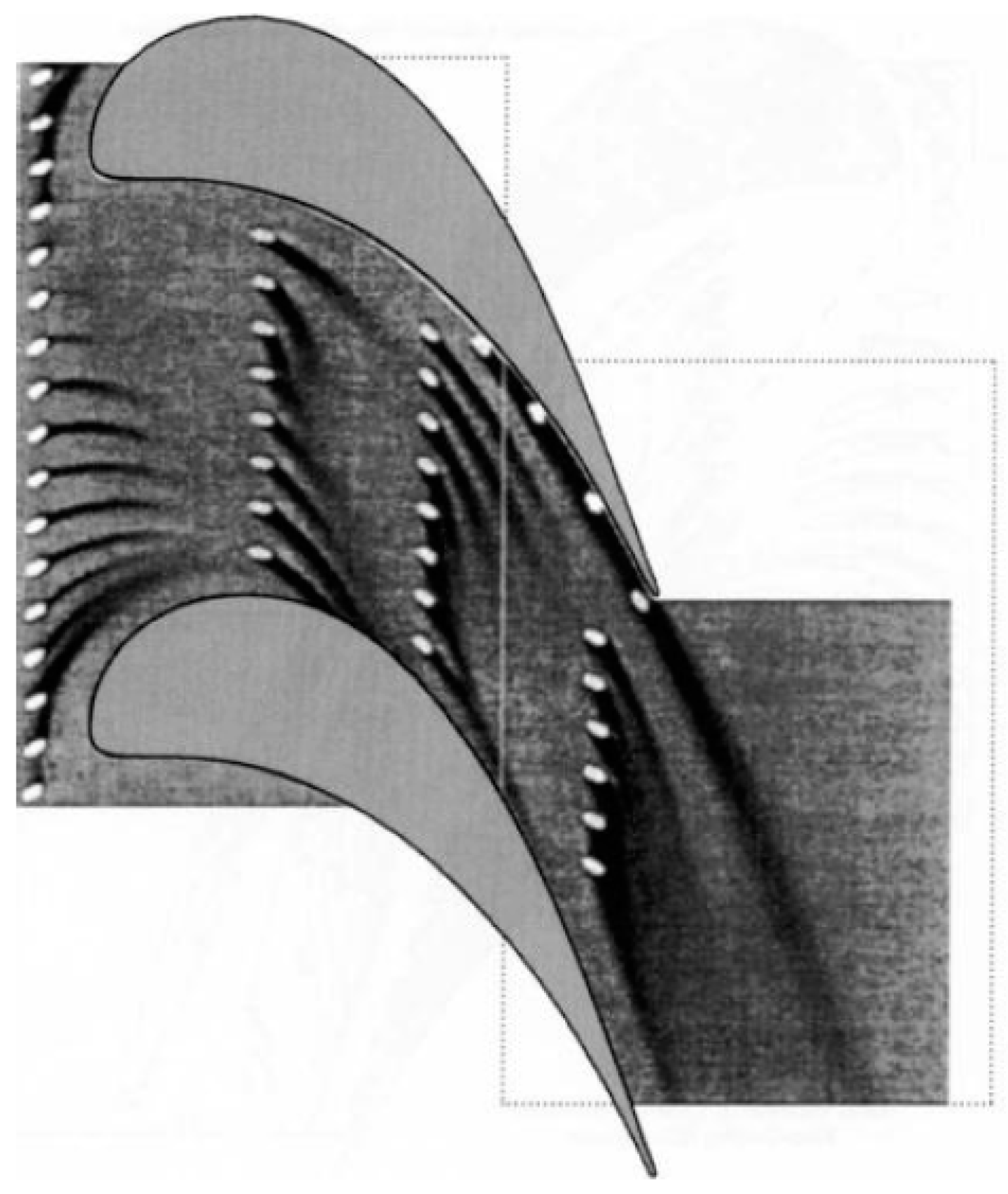
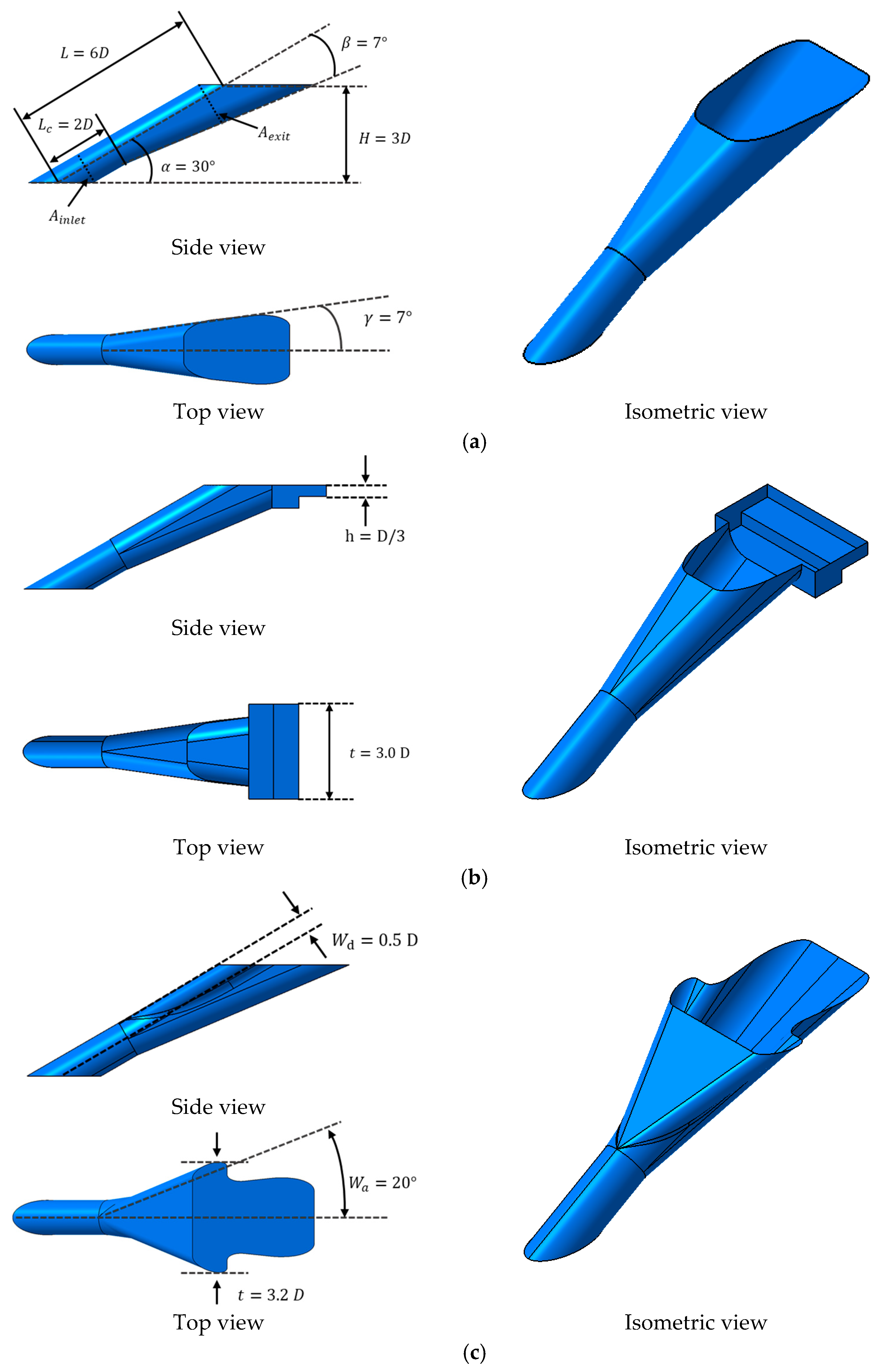

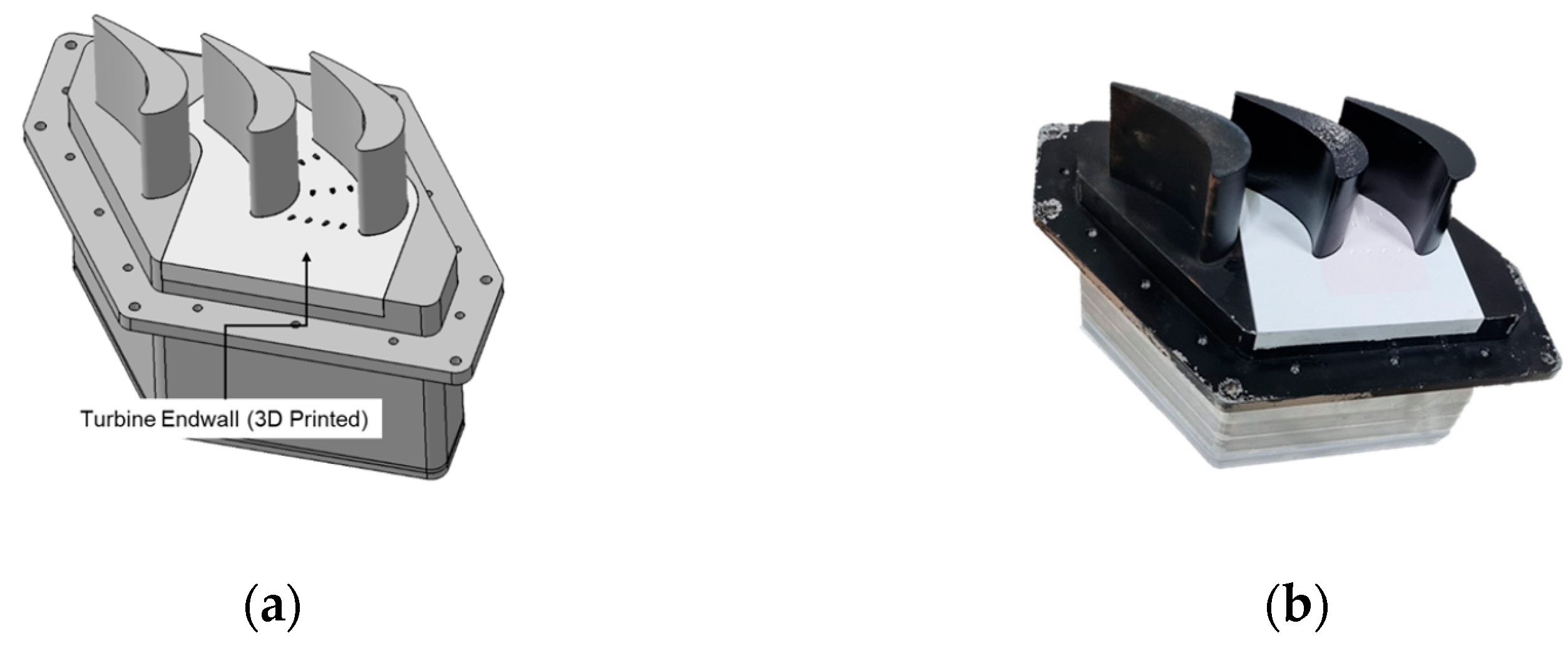
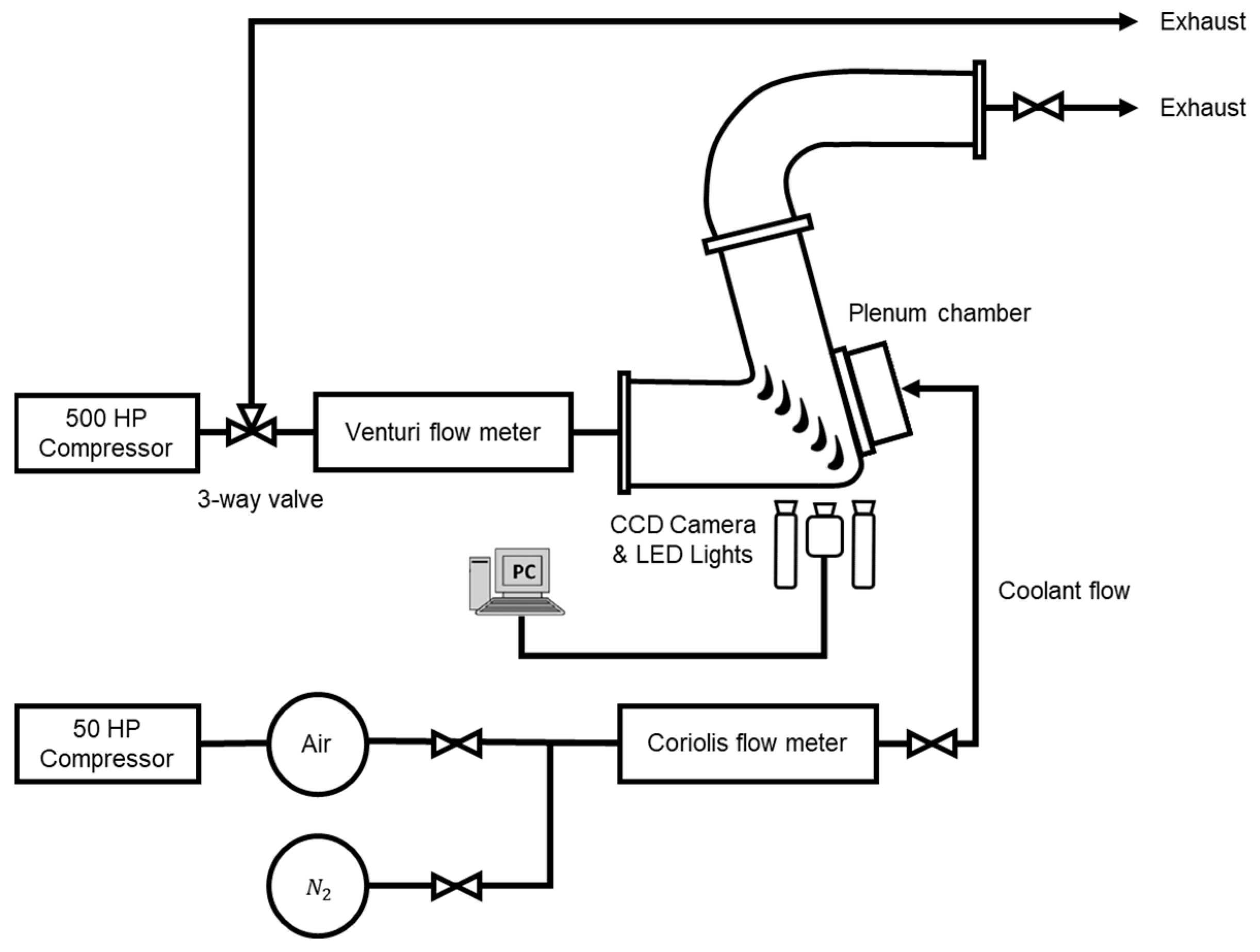
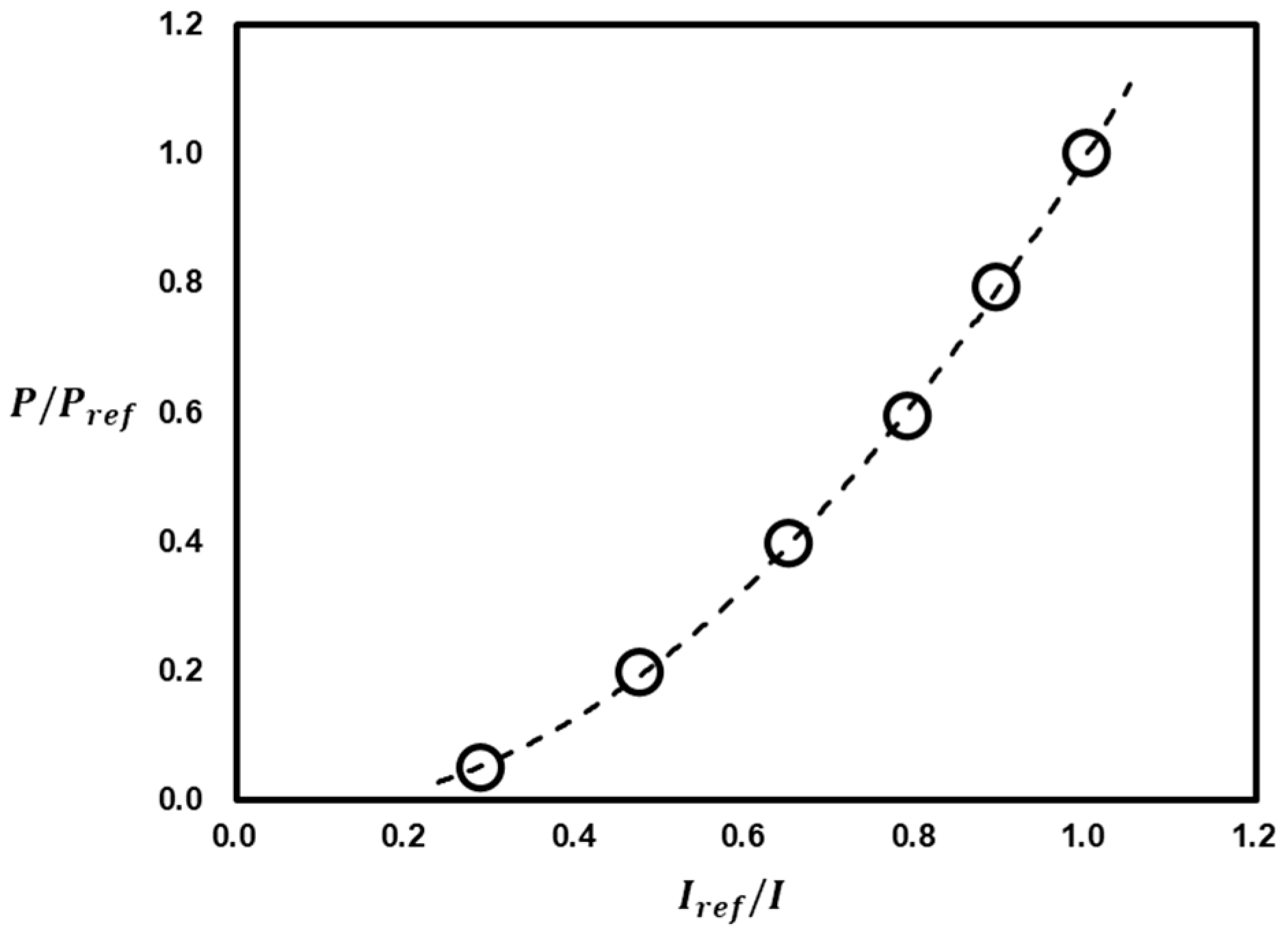
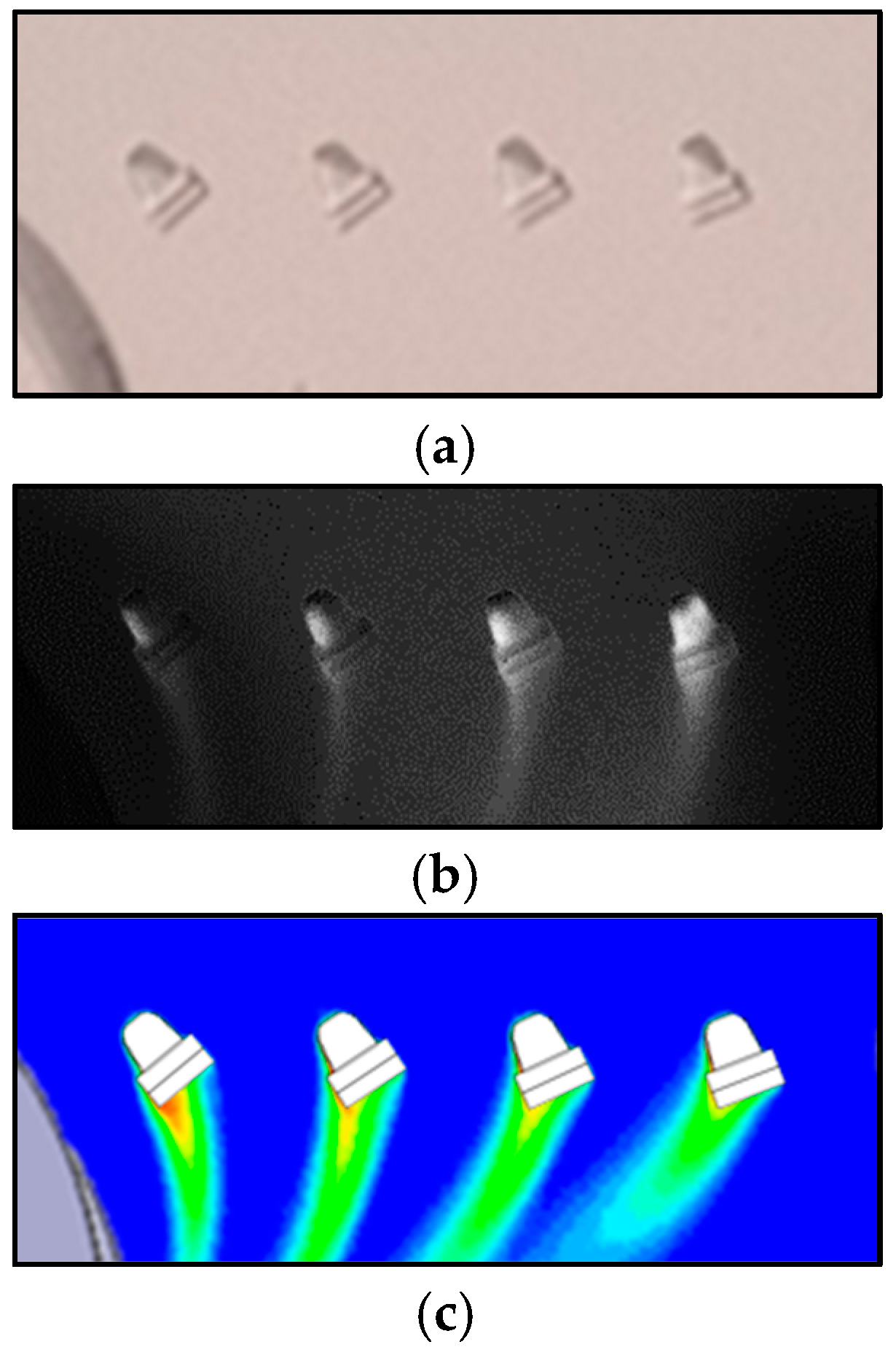

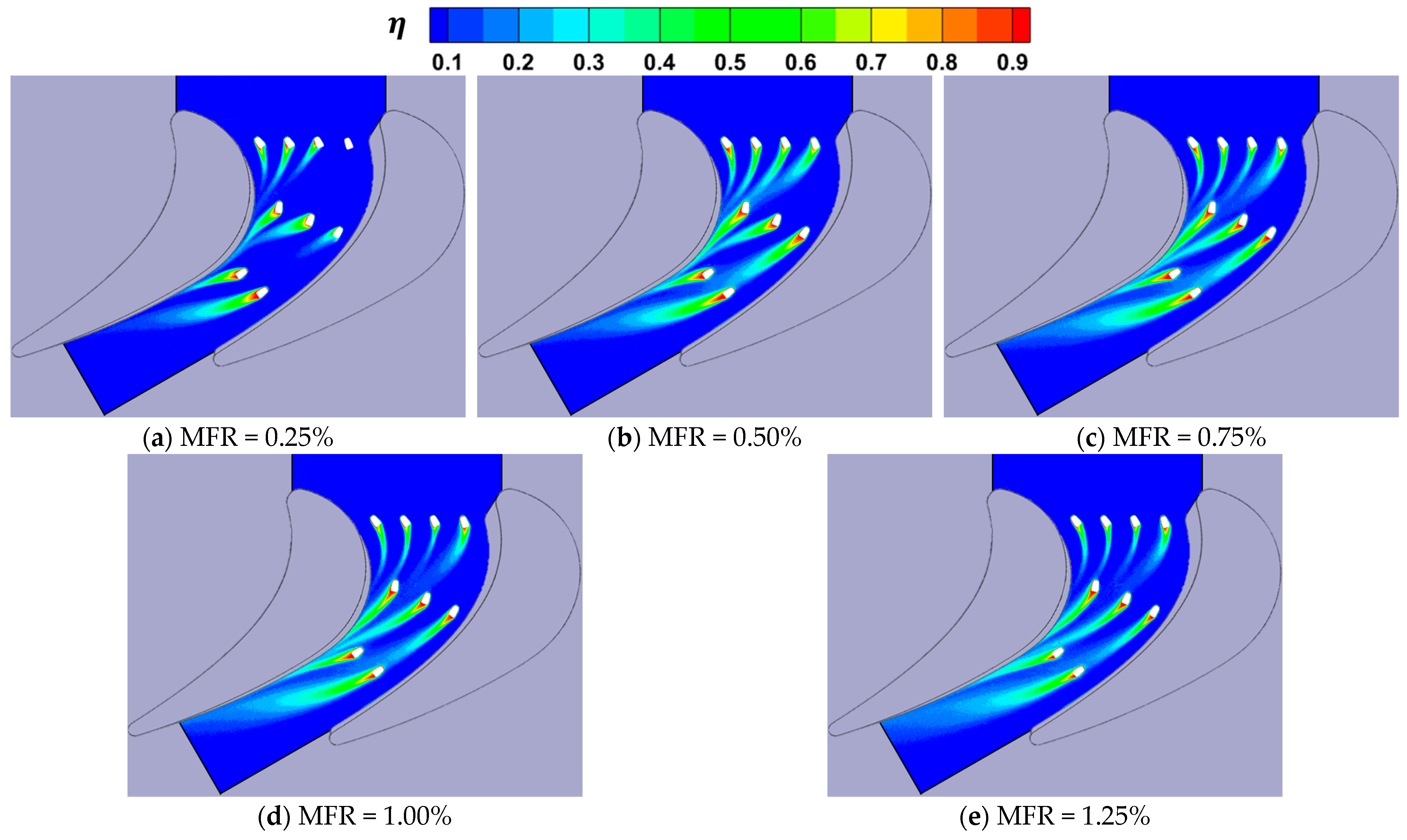
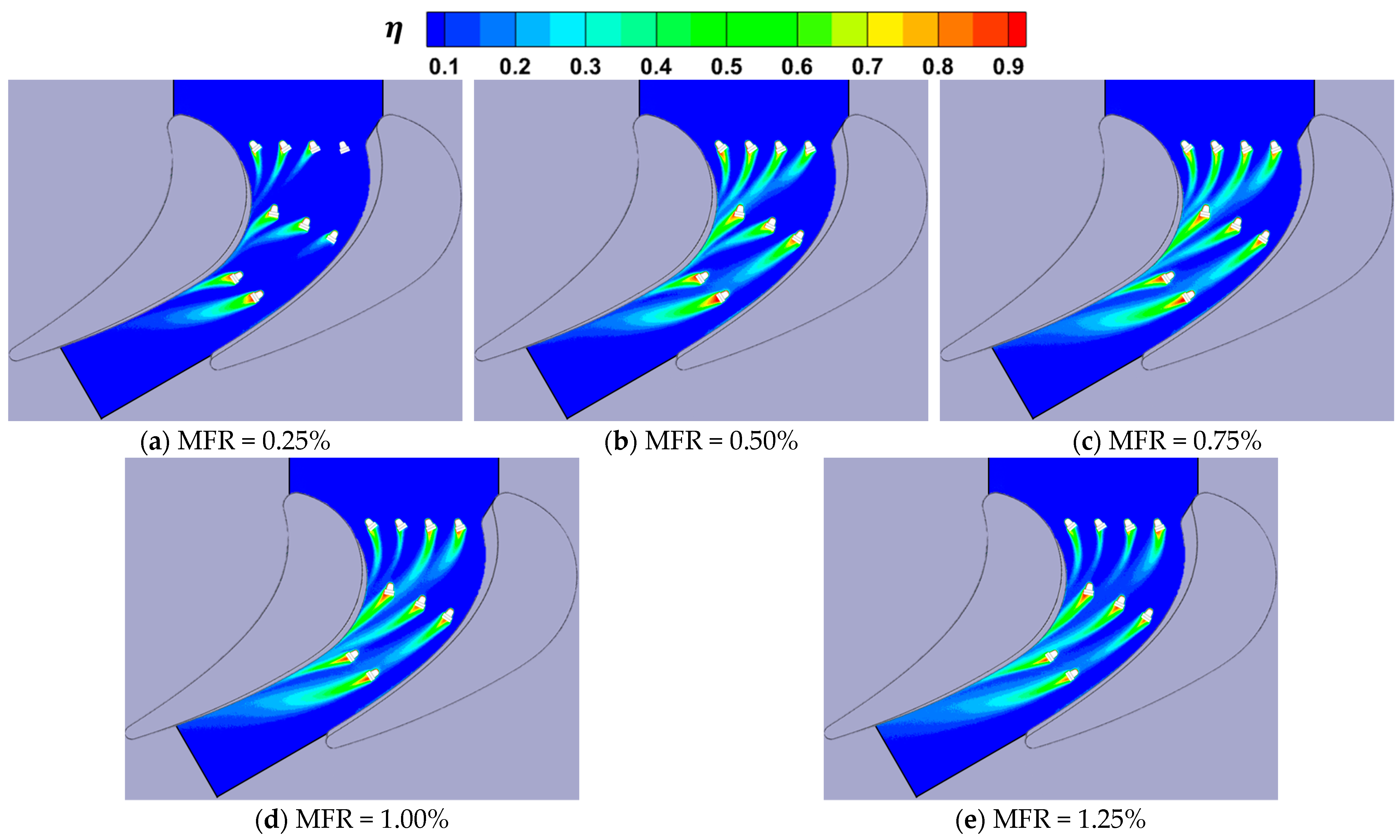
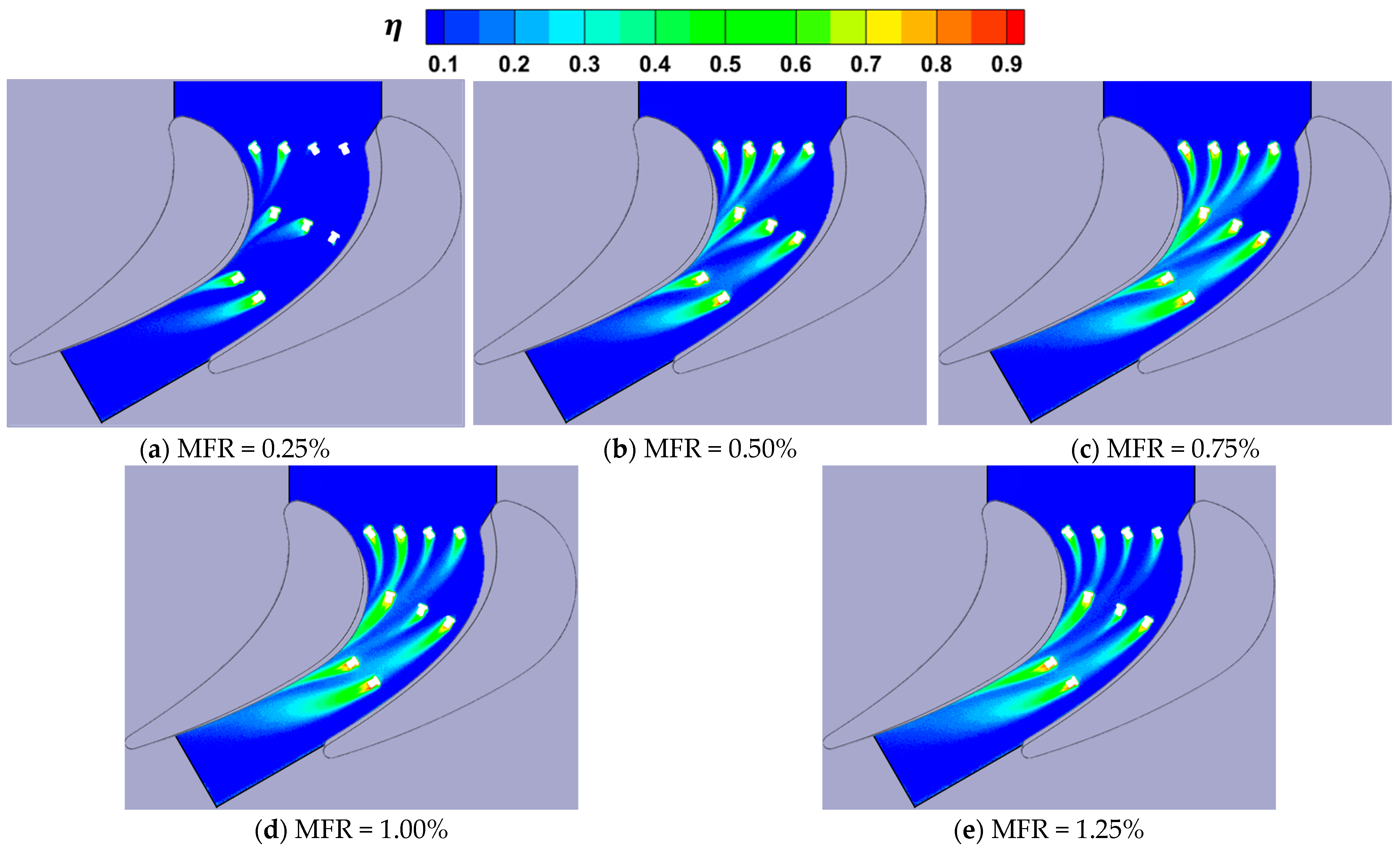






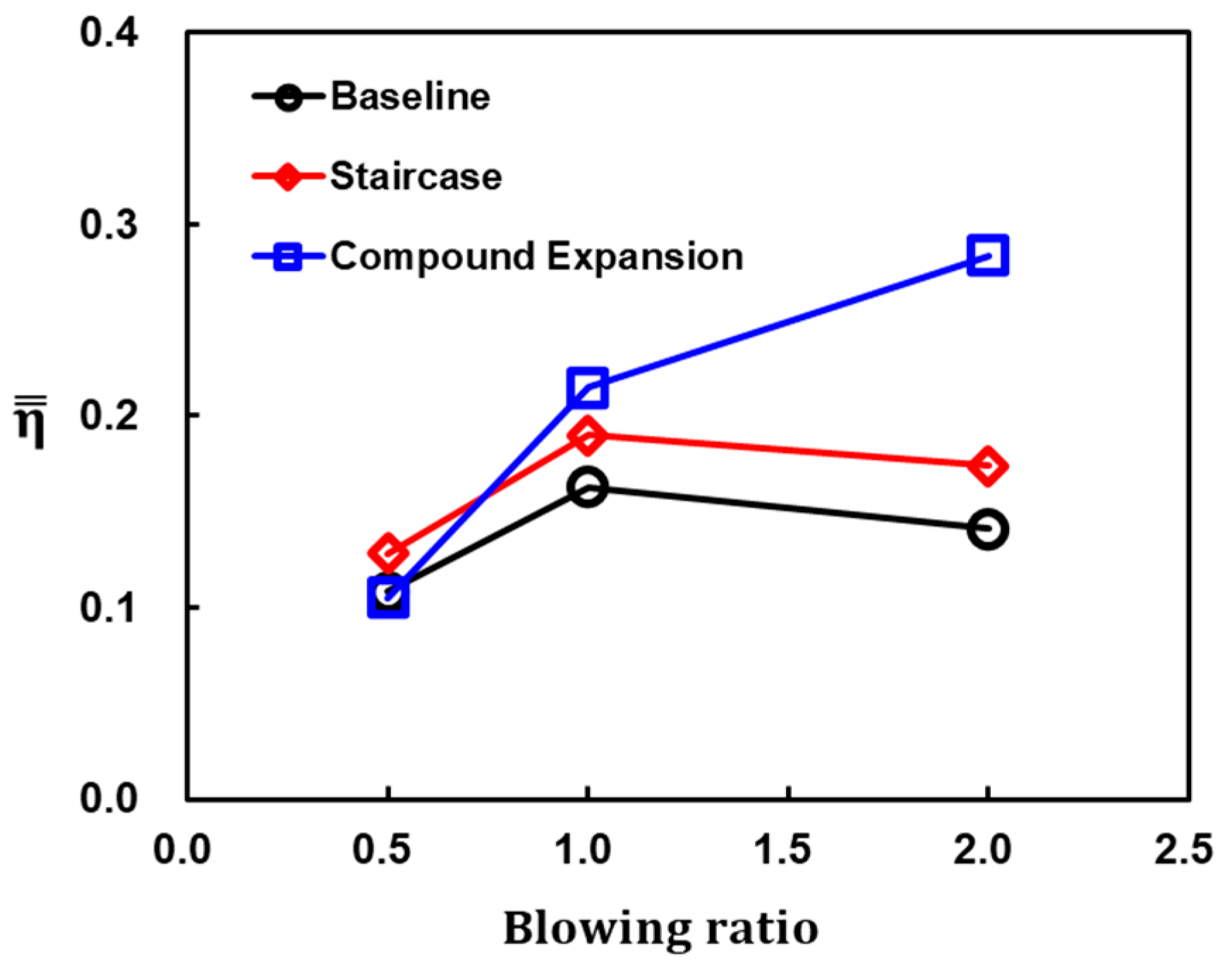
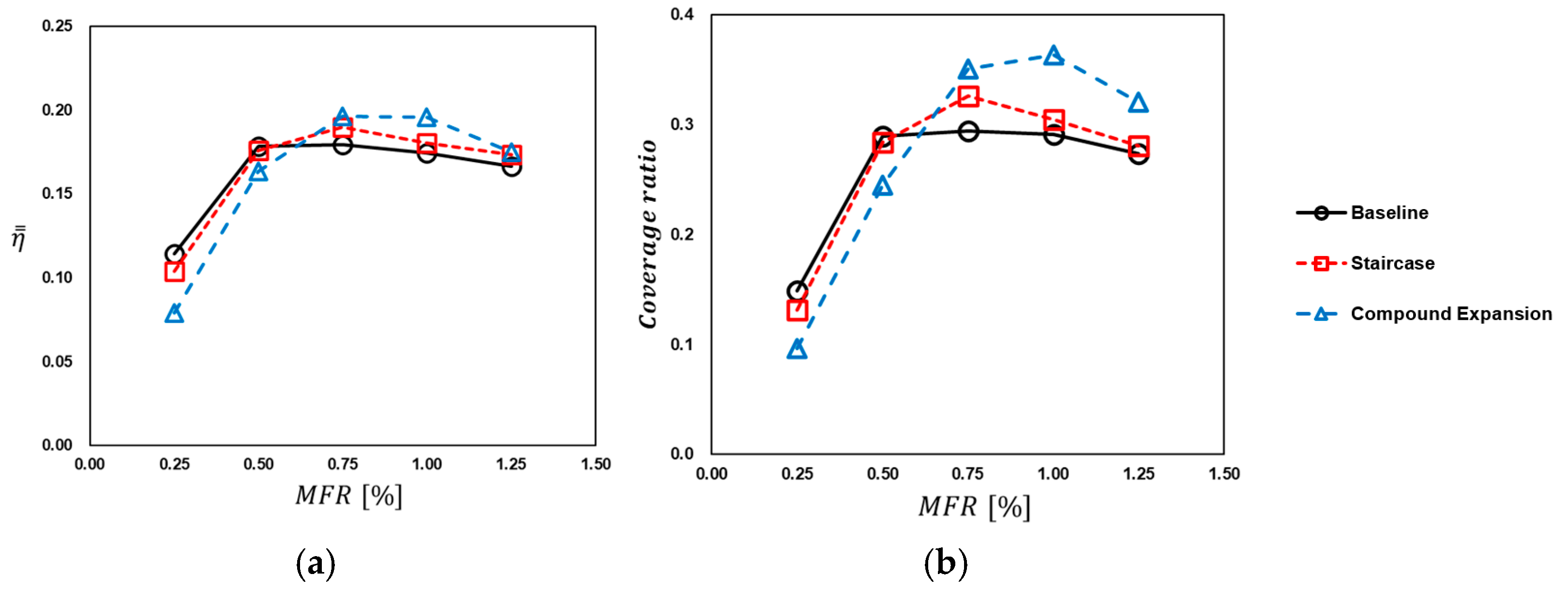
| Parameter | Value |
|---|---|
| Diameter (D) [mm] | 1.2 |
| Injection angle | 30 |
| 6 | |
| 2 | |
| Laidback expansion angle () [] | 7 |
| Lateral expansion angle () [] | 7 |
| Baseline | Staircase | Compound Expansion | |
|---|---|---|---|
| Coverage Ratio (t/D) | 2.29 | 3.00 | 3.19 |
| Area Ratio () | 2.85 | 2.85 | 3.59 |
| Note | - | Double-Step Structure @ Hole Exit | Additional Passage @ Hole Leading Edge |
| Row # | Hole # | FWD. Location | LAT. Location |
|---|---|---|---|
| 1 | 1 | 0.05 | 0.2 |
| 2 | 0.05 | 0.4 | |
| 3 | 0.05 | 0.6 | |
| 4 | 0.05 | 0.8 | |
| 2 | 1 | 0.36 | 0.2 |
| 2 | 0.42 | 0.5 | |
| 3 | 0.48 | 0.8 | |
| 3 | 1 | 0.68 | 0.3 |
| 2 | 0.77 | 0.7 |
| Mainstream Reynolds number | Inlet | 4.00 × 105 | ||||
| Outlet | 5.70 × 105 | |||||
| Density ratio ] | 1.0 | |||||
| Test condition | Case 1 | Case 2 | Case 3 | Case 4 | Case 5 | |
| Mass flow ratio (MFR) [%] | 0.25 | 0.50 | 0.75 | 1.00 | 1.25 | |
| Mean blowing ratio ] | Row 1 | 0.92 | 1.96 | 2.90 | 3.74 | 4.63 |
| Row 2 | 0.63 | 1.39 | 2.04 | 2.59 | 3.16 | |
| Row 3 | 0.72 | 1.07 | 1.41 | 1.73 | 2.08 | |
Disclaimer/Publisher’s Note: The statements, opinions and data contained in all publications are solely those of the individual author(s) and contributor(s) and not of MDPI and/or the editor(s). MDPI and/or the editor(s) disclaim responsibility for any injury to people or property resulting from any ideas, methods, instructions or products referred to in the content. |
© 2023 by the authors. Licensee MDPI, Basel, Switzerland. This article is an open access article distributed under the terms and conditions of the Creative Commons Attribution (CC BY) license (https://creativecommons.org/licenses/by/4.0/).
Share and Cite
Kim, S.; Lee, D.; Kang, Y.S.; Rhee, D.-H. Experimental Study on the Improvement of Film Cooling Effectiveness of Various Modified Configurations Based on a Fan-Shaped Film Cooling Hole on an Endwall. Energies 2023, 16, 7733. https://doi.org/10.3390/en16237733
Kim S, Lee D, Kang YS, Rhee D-H. Experimental Study on the Improvement of Film Cooling Effectiveness of Various Modified Configurations Based on a Fan-Shaped Film Cooling Hole on an Endwall. Energies. 2023; 16(23):7733. https://doi.org/10.3390/en16237733
Chicago/Turabian StyleKim, Seokmin, DongEun Lee, Young Seok Kang, and Dong-Ho Rhee. 2023. "Experimental Study on the Improvement of Film Cooling Effectiveness of Various Modified Configurations Based on a Fan-Shaped Film Cooling Hole on an Endwall" Energies 16, no. 23: 7733. https://doi.org/10.3390/en16237733
APA StyleKim, S., Lee, D., Kang, Y. S., & Rhee, D.-H. (2023). Experimental Study on the Improvement of Film Cooling Effectiveness of Various Modified Configurations Based on a Fan-Shaped Film Cooling Hole on an Endwall. Energies, 16(23), 7733. https://doi.org/10.3390/en16237733





